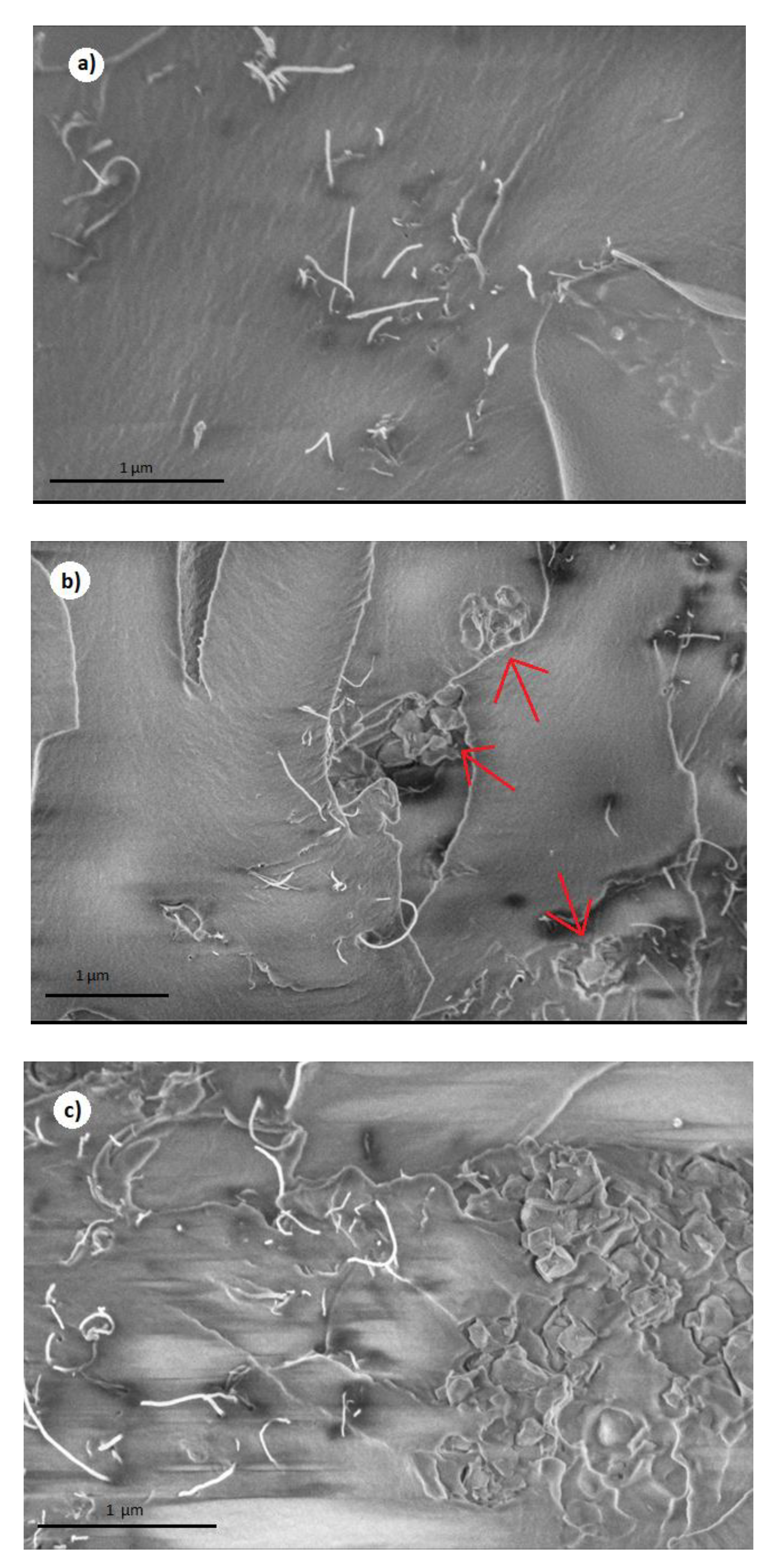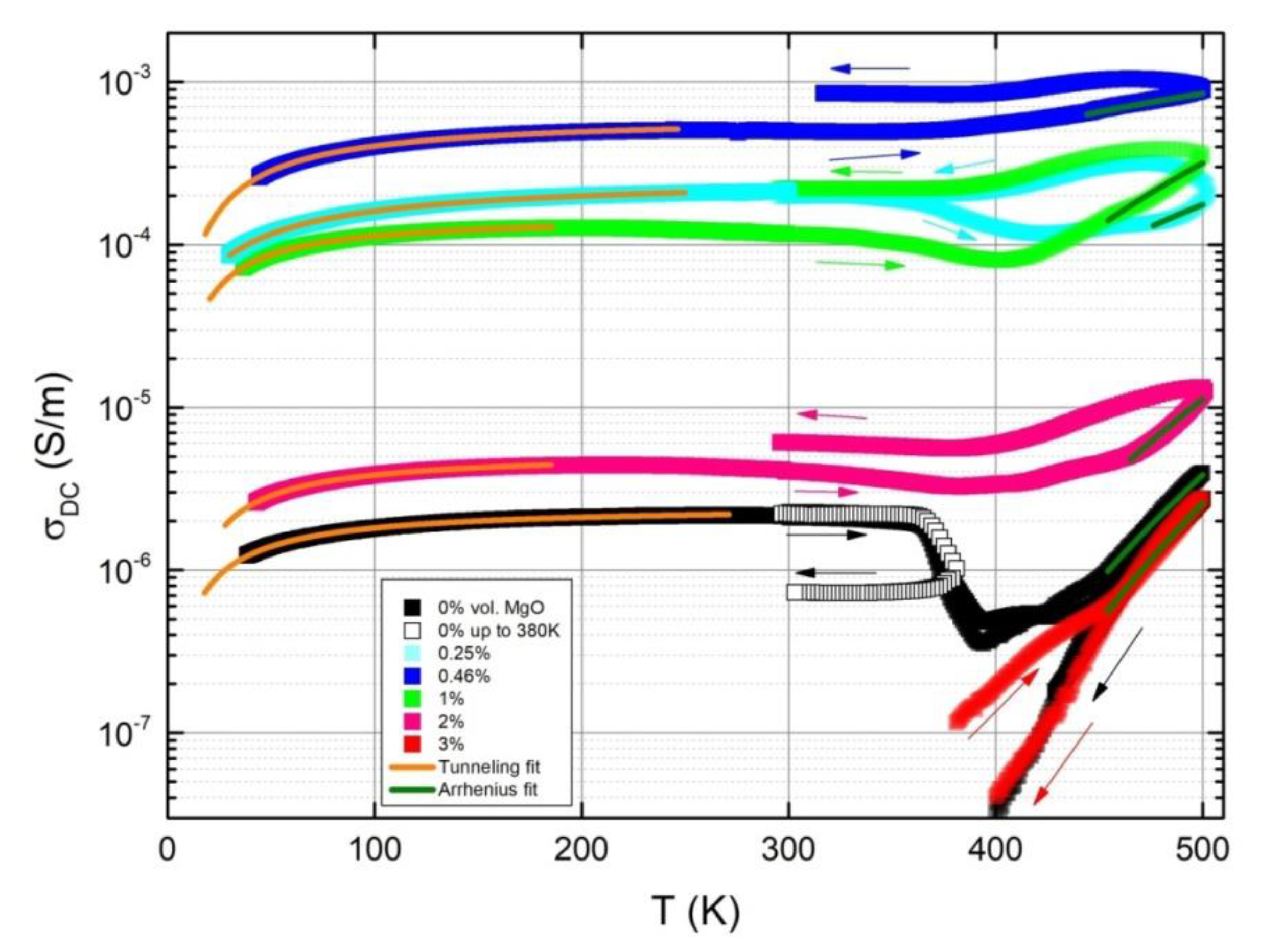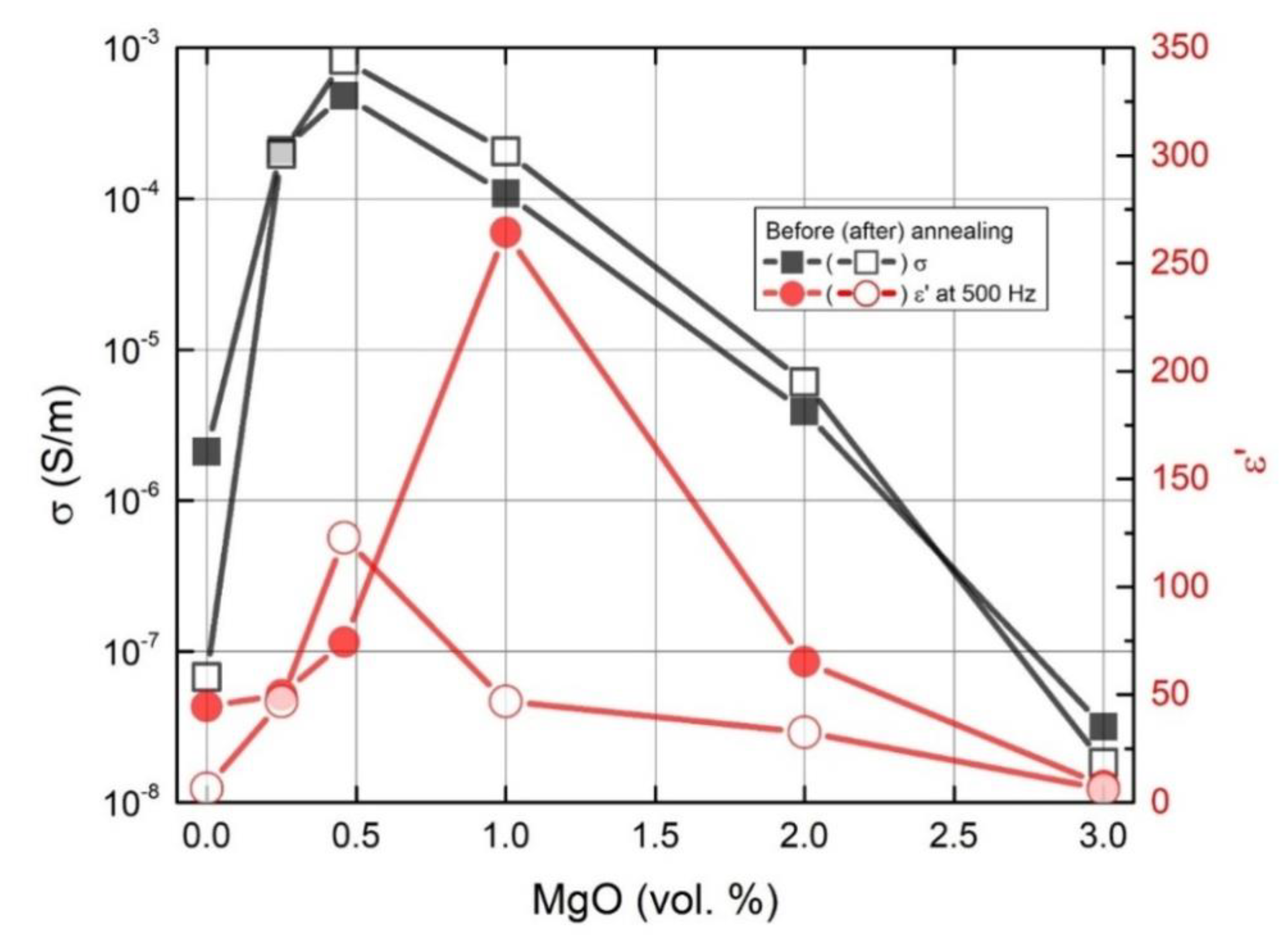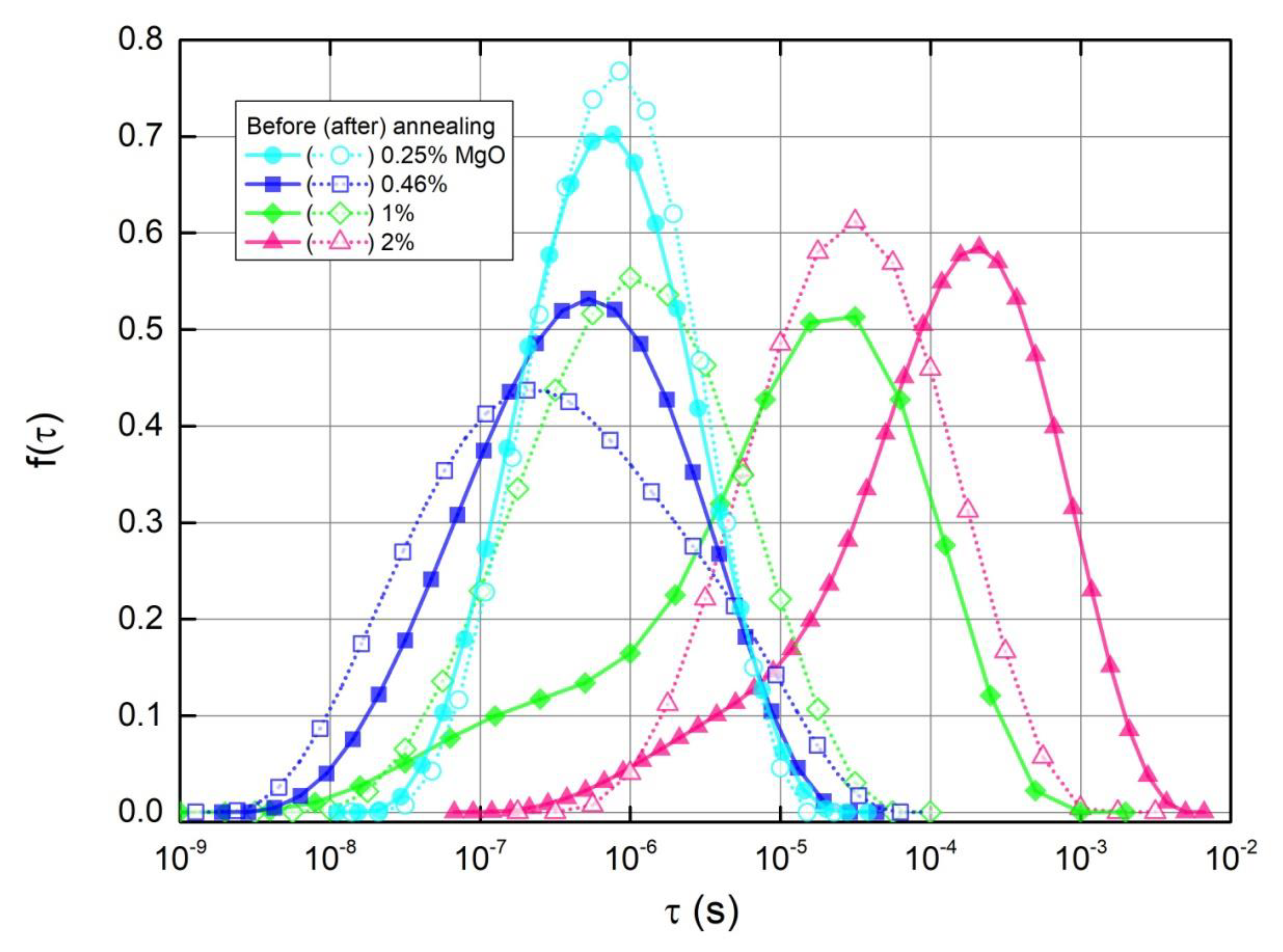Fine Tuning of Electrical Transport and Dielectric Properties of Epoxy/Carbon Nanotubes Composites via Magnesium Oxide Additives
Abstract
:1. Introduction
2. Materials and Methods
2.1. Materials
2.2. Preparation
2.3. Broadband Measurements
3. Results and Discussion
3.1. Room Temperature Properties
3.2. Electrical Transport at Different Temperatures
4. Conclusions
Author Contributions
Funding
Conflicts of Interest
References
- Sandler, J.; Shaffer, M.S.P.; Prasse, T.; Bauhofer, W.; Schulte, K.; Windle, A.H. Development of a dispersion process for carbon nanotubes in an epoxy matrix and the resulting electrical properties. Polymer 1999, 40, 5967–5971. [Google Scholar] [CrossRef]
- Ma, C.P.; Siddiqui, N.A.; Marom, G.; Kima, J.K. Dispersion and functionalization of carbon nanotubes for polymer-based nanocomposites: A review. Compos. Part A 2010, 41, 1345–1367. [Google Scholar] [CrossRef]
- Iijima, S.; Ichihashi, T. Single-shell carbon nanotubes of 1-nm diameter. Nature 1993, 363, 603–605. [Google Scholar] [CrossRef]
- Aravand, M.; Lomov, S.V.; Verpoest, I.; Gorbatikh, L. Evolution of carbon nanotube dispersion in preparation of epoxy-based composites: From a masterbatch to a nanocomposite. Polym. Lett. 2014, 8, 596–608. [Google Scholar] [CrossRef]
- Sandler, J.K.W.; Kirk, J.E.; Kinloch, I.A.; Shaffer, M.S.P.; Windle, A.H. Ultra-low percolation threshold in carbon-nanotube-epoxy composites. Polymer 2003, 44, 5893–5899. [Google Scholar] [CrossRef]
- Yang, X.; Fan, S.; Li, Y.; Guo, Y.; Li, Y.; Ruan, K.; Zhang, J.; Kong, J.; Gu, K. Synchronously improved electromagnetic interference shielding and thermal conductivity for epoxy nanocomposites by constructing 3D copper nanowires/thermally annealed graphene aerogel framework. Compos. Part A 2020, 128, 105670. [Google Scholar] [CrossRef]
- Liang, C.; Song, P.; Ma, A.; Shi, X.; Gu, H.; Wang, L.; Qiu, H.; Kong, J.; Gu, J. Highly oriented three-dimensional structures of Fe3O4 decorated CNTs/reduced graphene oxide foam/epoxy nanocomposite against electromagnetic pollution. Compos. Sci. Technol. 2019, 181, 107683. [Google Scholar] [CrossRef]
- Song, P.; Liang, C.; Wang, L.; Qiu, H.; Gu, H.; Kong, J.; Gu, J. Obviously improved electromagnetic interference shielding performances for epoxy composites via constructing honeycomb structural reduced graphene oxide. Compos. Sci. Technol. 2019, 181, 107698. [Google Scholar] [CrossRef]
- Tang, L.; He, M.; Na, X.; Guan, X.; Zhang, R.; Zhang, J. Functionalized glass fibers cloth spherical BN fillers/epoxy laminated composites with excellent thermal conductivities and electrical insulation properties. Compos. Commun. 2019, 16, 5–10. [Google Scholar] [CrossRef]
- Wang, H.; Zhu, K.; Yan, L.; Wei, C.; Zhang, Y.; Gong, C.; Guo, J.; Zhang, J.; Zhang, F.; Zhang, J. Efficient and scalable high-quality graphene nanodot fabrication through confined lattice plane electrochemical exfoliation. Chem. Commun. 2019, 55, 5805. [Google Scholar] [CrossRef]
- Shariatzadeh, B.; Moradi, O. Surface Functionalization of Multiwalled Carbon Nanotubes with Chitosan and Magnesium Oxide Nanoparticles by Microwave-Assisted Synthesis. Polym. Compos. 2014, 35, 2050–2055. [Google Scholar] [CrossRef]
- Prabhu, Y.T.; Rao, K.V.; Kumari, B.S.; Pavani, T. Decoration of magnesium oxide nanoparticles on O-MWCNTs and its antibacterial studies. Rend. Lincei 2015, 26, 263–270. [Google Scholar] [CrossRef]
- Patel, M.K.; Ali, M.A.; Srivastava, S.; Agrawal, V.V.; Ansari, S.G.; Malhotra, B.D. Magnesium oxide grafted carbon nanotubes based impedimetric genosensor for biomedical application. Biosens. Bioelectron. 2013, 50, 406–413. [Google Scholar] [CrossRef] [PubMed]
- Najafi, A. Development of high oxidation resistant coating of nanostructured MgO on carbon nanotubes via simple precipitation technique in Mg/CO gas system. Ceram. Int. 2016, 42, 18573–18578. [Google Scholar] [CrossRef]
- Sohrabi, L.; Taleshi, F.; Sohrabi, R. Effect of carbon nanotubes support on band gap energy of MgO nanoparticles. J. Mater. Sci. Mater. Electron. 2014, 25, 4110–4114. [Google Scholar] [CrossRef]
- Najafi, A. A novel synthesis method of nanostructured MgO-coated hollow carbon nanofibers via CO decomposition over Mg/MgO catalyst. Ceram. Int. 2017, 43, 9220–9225. [Google Scholar] [CrossRef]
- Arshad, A.; Iqbal, K.; Siddiq, M.; Mansoor, Q.; Ismail, M.; Mehmood, F.; Ajmal, M.; Abid, Z. Graphene nanoplatelets induced tailoring in photocatalytic activity and antibacterial characteristics of MgO/graphene nanoplatelets nanocomposites. J. Appl. Phys. 2017, 121, 024901. [Google Scholar] [CrossRef]
- Du, F.P.; Tang, H.; Huang, D.Y. Thermal Conductivity of Epoxy Resin Reinforced with Magnesium Oxide Coated Multiwalled Carbon Nanotubes. Int. J. Polym. Sci. 2013, 2013, 541823. [Google Scholar] [CrossRef] [Green Version]
- Nemeth, K.; Reti, B.; Posa, M.; Belina, K.; Hernadi, K. SiO2/MgO coated multiwalled carbon nanotubes in polymer composites. Phys. Status Solidi B 2012, 249, 2333–2336. [Google Scholar] [CrossRef]
- Nemeth, K.; Kovacs, L.; Reti, B.; Belina, K.; Hernadi, K. The Synthesis and Investigation of SiO2–MgO Coated Multiwalled Carbon Nanotube/Polymer Composites. J. Nanosci. Nanotechnol. 2017, 17, 5445–5452. [Google Scholar] [CrossRef]
- Okotrub, A.V.; Bulusheva, A.G.; Kudashov, A.G.; Belavin, V.V. Komogortsev. Nanotechnology 2008, 3, 197200. (In Russia) [Google Scholar]
- Available online: https://www.us-nano.com/inc/sdetail/244 (accessed on 9 December 2019).
- Available online: https://www.sigmaaldrich.com/catalog/product/aldrich/90460?lang=en®ion=LT&gclid=CjwKCAiA8qLvBRAbEiwAE_ZzPQsDsOAxhEpXl-jywNKe0nCY67gCO-yCnsqSqqu7Zf_dkKLYSiHCehoCxtMQAvD_BwE (accessed on 9 December 2019).
- Yuan, Q.; Zeng, X.; Liu, Y.; Luo, L.; Wu, J.; Wang, Y.; Zhou, G. Microstructure and mechanical properties of AZ91 alloy reinforced by carbon nanotubes coated with MgO. Carbon 2016, 96, 843–855. [Google Scholar] [CrossRef]
- Xie, Q.; Ohki, Y.; Hirai, N.; Cheng, Y.-H. Improved High-temperature Dielectric Property of Epoxy Resin Composites with Nano- and Micro-sized Magnesia Fillers. In Proceedings of the 2017 IEEE International Workshop on Integrated Power Packaging (IWIPP), Delft, The Netherlands, 5–7 April 2017. [Google Scholar]
- Aguilar, J.O.; Bautista-Quijano, J.R.; Aviles, F. Influence of carbon nanotubes clustering on the electrical conductivity of polymer composites films. Express Polym. Lett. 2010, 4, 292–299. [Google Scholar] [CrossRef]
- Xie, Q.; Cheng, Y.-H.; Hirai, N.; Ohki, Y. Space Charge distribution in Epoxy/MgO Nanocomposites at Various Tempertures. In Proceedings of the 2016 IEEE International Conference on High Voltage Engineering and Application (ICHVE), Chengdu, China, 19–22 September 2016. [Google Scholar]
- Macutkevic, J.; Kuzhir, P.; Paddubskaya, A.; Maksimenko, S.; Banys, J.; Celzard, A.; Fierro, V.; Bistarelli, S.; Cataldo, A.; Micciulla, F.; et al. Electrical transport in carbon black-epoxy resin composites at different temperatures. J. Appl. Phys. 2013, 114, 033707. [Google Scholar] [CrossRef]
- Sheng, P.; Sichel, E.K.; Gittleman, J.K. Fluctuation-induced tunneling conduction in carbon-polyvinylchloride composites. Phys. Rev. Lett. 1978, 40, 1197. [Google Scholar] [CrossRef]
- Macutkevic, J.; Kuzhir, P.P.; Paddubskaya, A.G.; Banys, J.; Maksimenko, S.A.; Stefanutti, E.; Micciulla, F.; Bellucci, S. Broadband dielectric/electric properties of epoxy thin films filled with multiwalled carbon nanotubes. J. Nanophotonics 2013, 7, 073593. [Google Scholar] [CrossRef]
- Gao, J.F.; Yan, D.X.; Yuan, B.; Huang, H.D.; Li, Z.M. Large-scale fabrication and electrical properties of anisotropic conductive polymer composite utilizing preferable location of carbon in a polymer blend. Compos. Sci. Technol. 2010, 70, 1973–1979. [Google Scholar] [CrossRef]
- Li, G.; Hu, C.; Zhai, W.; Zhao, S.; Zheng, G.; Das, K.; Liu, C. Particle size induced tunable positive temperature coefficient characteristic in electrically conductive carbon nanotubes/polypropylene composites. Mater. Lett. 2016, 182, 314–317. [Google Scholar] [CrossRef]
- Liu, J.; Duan, C.G.; Yin, W.G.; Mei, W.N.; Smith, R.W.; Hardy, J.R. Large dielectric constant and Maxwell-Wagner relaxation in Bi2/3Cu3Ti4O12. Phys. Rev. B 2004, 70, 144106. [Google Scholar] [CrossRef]
- Macutkevic, J.; Banys, J.; Matulis, A. Determination of the Distribution of the Relaxation Times from Dielectric Spectra. Nonlin. Anal. Model. Control 2004, 9, 75–84. [Google Scholar]








| MgO Content (vol. %) | σDC (S/m) | A (S) | s |
|---|---|---|---|
| 0 | 1.54 × 10−6 | 1.55 × 10−8 | 0.67 |
| 0.25 | 2.45 × 10−4 | 5.96 × 10−9 | 0.73 |
| 0.46 | 3.93 × 10−4 | 6.99 × 10−8 | 0.64 |
| 1 | 9.18 × 10−5 | 8.23 × 10−8 | 0.63 |
| 2 | 3.54 × 10−6 | 1.36 × 10−8 | 0.69 |
| MgO (vol.%) | σ0 (S/m) | T1 (K) | T0 (K) | w (nm) | |
|---|---|---|---|---|---|
| 0 | 2.5 × 10−6 | 34.8 | 10.3 | 7.6 | 4.9 |
| 0.25 | 2.6 × 10−4 | 57.4 | 22.1 | 8.3 | 3.7 |
| 0.46 | 6.1 × 10−4 | 45.7 | 9.3 | 9.9 | 6.4 |
| 1 | 1.5 × 10−4 | 30.6 | 5.4 | 8.9 | 7.8 |
| 2 | 5.3 × 10−6 | 33.5 | 4.7 | 10.1 | 9.2 |
| MgO Content (vol. %) | ||
|---|---|---|
| 0 | 1.038 | 6751 ( |
| 0.25 | 7.391 | 713 () |
| 0.46 | 4.737 | 1168 (0.1) |
| 1 | 2.75 | 5417 ( |
| 2 | 1.904 | 6631 () |
| 3 | 3.348 | 8090 () |
© 2019 by the authors. Licensee MDPI, Basel, Switzerland. This article is an open access article distributed under the terms and conditions of the Creative Commons Attribution (CC BY) license (http://creativecommons.org/licenses/by/4.0/).
Share and Cite
Bertasius, P.; Meisak, D.; Macutkevic, J.; Kuzhir, P.; Selskis, A.; Volnyanko, E.; Banys, J. Fine Tuning of Electrical Transport and Dielectric Properties of Epoxy/Carbon Nanotubes Composites via Magnesium Oxide Additives. Polymers 2019, 11, 2044. https://doi.org/10.3390/polym11122044
Bertasius P, Meisak D, Macutkevic J, Kuzhir P, Selskis A, Volnyanko E, Banys J. Fine Tuning of Electrical Transport and Dielectric Properties of Epoxy/Carbon Nanotubes Composites via Magnesium Oxide Additives. Polymers. 2019; 11(12):2044. https://doi.org/10.3390/polym11122044
Chicago/Turabian StyleBertasius, Povilas, Darya Meisak, Jan Macutkevic, Polina Kuzhir, Algirdas Selskis, Elena Volnyanko, and Juras Banys. 2019. "Fine Tuning of Electrical Transport and Dielectric Properties of Epoxy/Carbon Nanotubes Composites via Magnesium Oxide Additives" Polymers 11, no. 12: 2044. https://doi.org/10.3390/polym11122044







